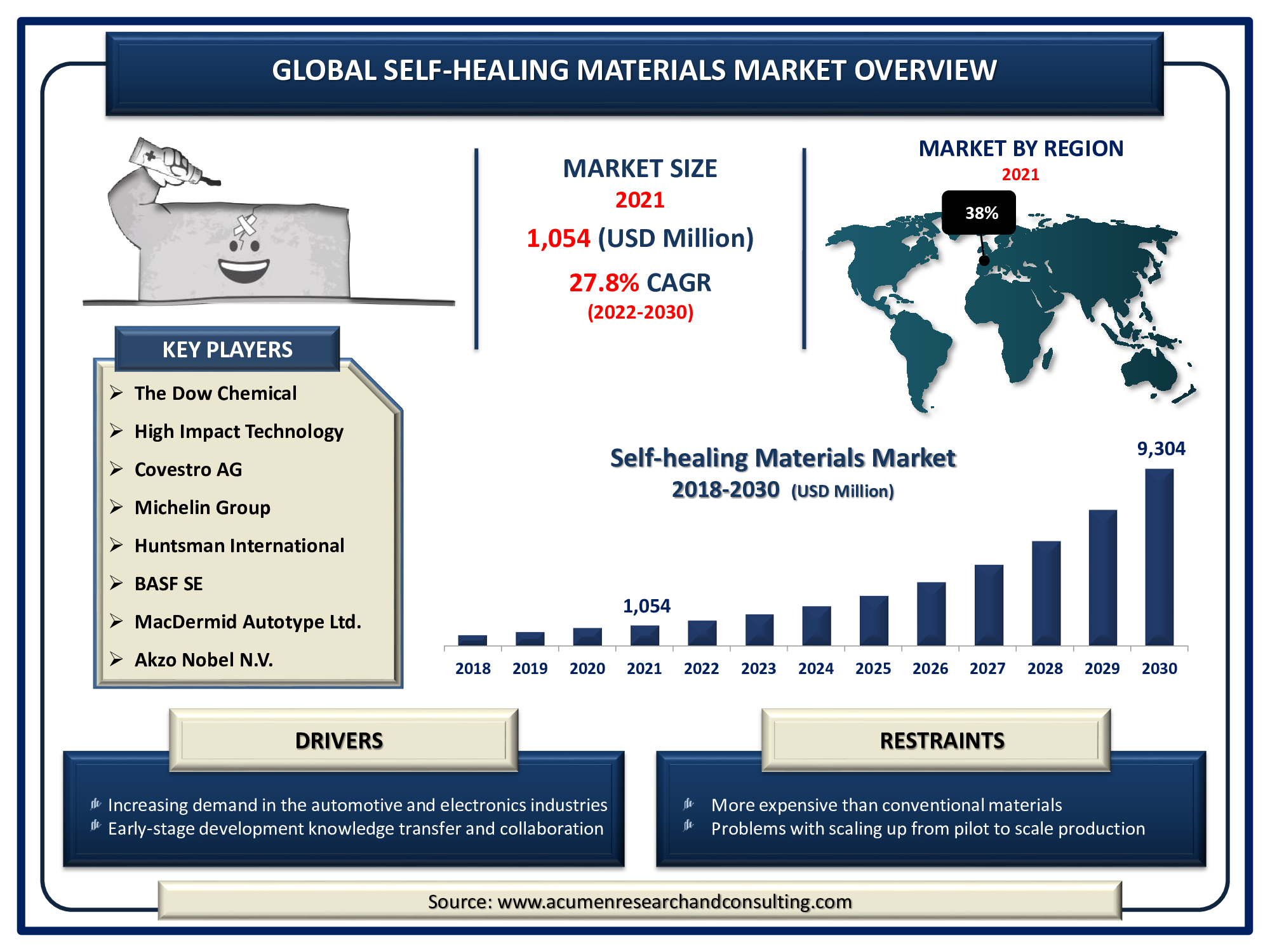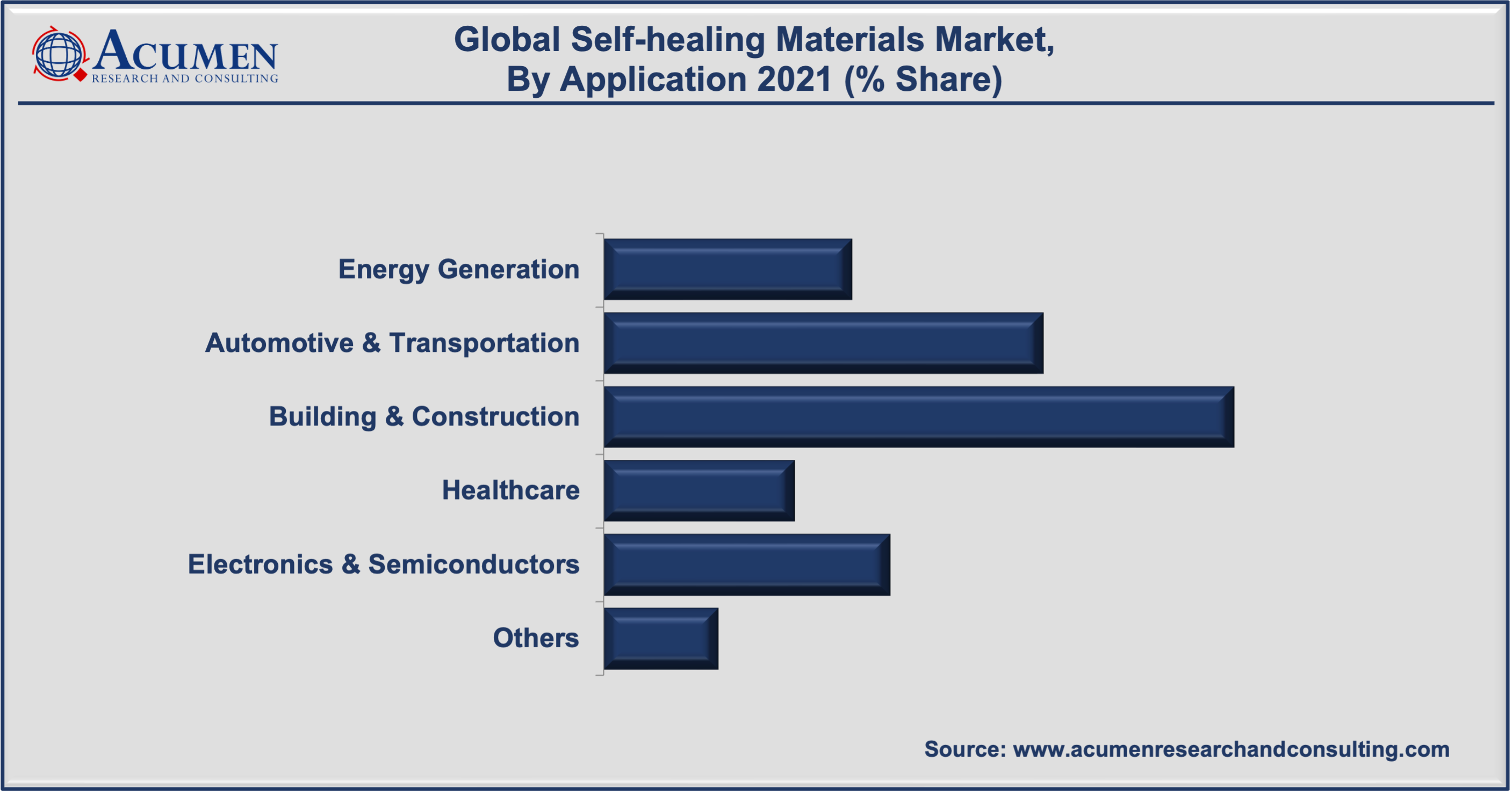Self Healing Materials Market | Acumen Research and Consulting
Self-healing Materials Market Analysis - Global Industry Size, Share, Trends and Forecast 2022 - 2030
Published :
Report ID:
Pages :
Format : ![]()
The Global Self-healing Materials Market size accounted for USD 1,054 Million in 2021 and is expected to reach USD 9,304 Million by 2030 with a considerable CAGR of 27.8% during the forecast period from 2022 to 2030.

The primary driver of the self-healing materials market is their effective properties, which significantly reduce the amount of maintenance required to restore damages. Furthermore, continues to advance in the advanced material domain aimed at self-healing, growing adoption of such materials in the healthcare, automobiles, building, and electronics industries, and their superior long-term economic rewards over conventional techniques are expected to drive self-healing materials market growth.
Self-healing materials can repair tensile or compressive cracks and overuse damage without requiring manual intervention. The main advantage of self-healing materials is that they lower the cost of various industrial applications that are commonly used to maintain and reconstruct the damage. It is also used to increase the life of materials and reduce inefficiency induced by degradation. Due to their unique properties, self-healing materials are used in a variety of fields, including electronics, automotive, aerospace, and marine, biomedicine, and coatings. High precision and prototypes of self-healing materials are commonly used for industrial and commercial applications of these material properties in a range of fields.
Self-healing Materials Market Dynamics
Drivers
- Increasing demand in the automotive and electronics industries
- Self-healing materials yield long-term economic advantages compared to conventional materials
- Government policy diverts attention to legislation and regulations mandating extended service assurances or warranties
- Early-stage development knowledge transfer and closer collaboration
Restraints
- Self-healing materials are currently more expensive than conventional materials
- Problems with scaling up from pilot to industrial-scale production
Opportunity
- Wide range of applications where dependability and durability are critical
- Increasing infrastructure and development activities in emerging economies
Report Coverage
| Market | Self-healing Materials Market |
| Market Size 2021 | USD 1,054 Million |
| Market Forecast 2030 | USD 9,304 Million |
| CAGR During 2022 - 2030 | 27.8% |
| Analysis Period | 2018 - 2030 |
| Base Year | 2021 |
| Forecast Data | 2022 - 2030 |
| Segments Covered | By Product, By Technology, By Application, And By Geography |
| Regional Scope | North America, Europe, Asia Pacific, Latin America, and Middle East & Africa |
| Key Companies Profiled | The Dow Chemical Company, High Impact Technology, LLC, Covestro AG, Michelin Group, Huntsman International LLC, BASF SE, MacDermid Autotype Ltd., Akzo Nobel N.V., NEI Corporation, and Evonik Industries Corporation. |
| Report Coverage |
Market Trends, Drivers, Restraints, Competitive Analysis, Player Profiling, Regulation Analysis |
| Customization Scope |
10 hrs of free customization and expert consultation |
The beneficial properties of this material, such as improved physical and chemical stability, weightlessness, and ease of processing, are driving the growth of the global self-healing material market, creating this specimen highly demanded in a variety of industries. Furthermore, the potential of materials to restore mechanical interfacial damage, as well as a substantial increase in adoption of advanced self-repairing polymer composites from various end-use businesses, drive self-healing materials market trend. As a result, the rising use of self-healing materials in the auto body, building and construction, and electronics and electrical sectors contributes to the global expansion of the market.
The increased rate of highway and public infrastructure construction, particularly in emerging countries, is one of the key factors driving the growth of the self-healing materials market size. The increasing usage of self-healing materials due to their ability to recover thermal or mechanical friction damage, as well as the transition from conventional processes to advanced technologies due to the long-term benefits, all have an influence on the self-healing materials market. Moreover, the steadily increasing adoption of advanced self-repairs polymeric materials from the end-use sector, as well as the emergence of self-healing microcapsules, which typically contain rejuvenators to reduce crack initiation in asphalt active ingredients, are propelling the self-healing materials market forward. Furthermore, Technological developments, government structural transformation toward legislation, end-user industry growth, technology transfer and closer collaboration at the beginning stages, rapid urbanization, and massive increase in investment all benefit the self-healing materials industry. Furthermore, a wide range of application bases where reliability and durability are extremely crucial provides lucrative opportunities to self-healing materials market participants over the projected time frame.
Self-healing Materials Market Segmentation
The global self-healing materials market segmentation is based on product, technology, application, and region.
Self-healing Materials Market By Product
- Concrete
- Polymers
- Coatings
- Fiber-reinforced Composites
- Ceramic
- Asphalt
- Metals

Based on the product, the coating segment is expected to have the largest market share in 2021. This is because of its diverse operational properties, which include excellent strength, limited shrinkage and creep, good stiffness, and cost-effectiveness. The growing use of these product portfolios in the manufacturing sector, including automotive and aviation, is driving advancements in self-healing coatings. Furthermore, these coatings are used in a variety of industries, including aviation, machinery manufacturing, oil and natural gas, the maritime sector, the automobile industry, and consumer products.
Self-healing Materials Market By Technology
- Reversible Polymers
- Shape Memory Materials
- Microencapsulation
- Biological Material Systems
- Others
Based on technology, the reversible polymers segment will dominate the market in 2021. The rise in demand from the medical infrastructure sector as the scope of applications expands is also contributing significantly to the emergence of reversible polymers. Furthermore, the market for microencapsulation is projected to accelerate significantly in the coming years. Growing demand for nutraceutical and pharmaceutical products, rising demand for functional ingredients, rapid expansion in the personal care industry, continued growth for microencapsulated ingredients due to potential applications in the home services and medical industries, and rising research funding for continuous efficiency drive the microencapsulation segment.
Self-healing Materials Market By Application
- Energy Generation
- Automotive & Transportation
- Building & Construction
- Healthcare
- Electronics & Semiconductors
- Others

In terms of application, the building and construction segment held the largest market share in 2021. The increased use of self-healing materials in residential and non-residential construction projects for excellent durability and high strength is one of the important factors driving the self-healing materials in the construction & building segment. Furthermore, rising government and commercial investment in construction and building activities, as well as an increase in green city projects, particularly in developing regions, are driving the demand for self-healing materials in the construction and building industry. The growing socio-economic need in emerging economies for high-tech architecture and structures is expected to propel the development industry forward during the projected timeframe, significantly improving self-healing materials market share.
Self-healing Materials Market Regional Outlook
North America
- U.S.
- Canada
Europe
- U.K.
- Germany
- France
- Spain
- Rest of Europe
Latin America
- Mexico
- Brazil
- Rest of Latin America
Asia-Pacific
- India
- Japan
- China
- Australia
- South Korea
- Rest of Asia-Pacific
The Middle East & Africa (MEA)
- Gulf Cooperation Council (GCC)
- South Africa
- Rest of the Middle East & Africa
The Europe region is expected to grow with significant market shares in 2021, owing to rising adoption rates and rapid advancement in the construction and automotive industries, which drive market demand in this region. Furthermore, increased company expansion in countries such as Germany and Italy drives market demand. Europe dominates the self-healing materials market due to the widespread use of self-repairing high-quality polymers, sophisticated research and development activities, increased automobile manufacturing, and process improvements. Due to technological advancements that have resulted in new consumer demands, the European automobile industry has grown at an exponential rate. In addition, the increased use of self-healing polymers in the automotive and electronics industries in the region is driving up the demand for self-healing materials in Europe.
Self-healing Materials Market Players
Some of the prominent global self-healing materials market companies are The Dow Chemical Company, High Impact Technology, LLC, Covestro AG, Michelin Group, Huntsman International LLC, BASF SE, MacDermid Autotype Ltd., Akzo Nobel N.V., NEI Corporation, and Evonik Industries Corporation.
Frequently Asked Questions
How big was the global self-healing materials market in 2021?
The global self-healing materials market accounted for USD 1,054 Million in 2021.
What will be the projected CAGR for global self-healing materials market during forecast period of 2022 to 2030?
The projected CAGR of self-healing materials during the analysis period of 2022 to 2030 is 27.8%.
Which are the prominent competitors operating in the market?
The prominent players of the global self-healing materials market involve The Dow Chemical Company, High Impact Technology, LLC, Covestro AG, Michelin Group, Huntsman International LLC, BASF SE, MacDermid Autotype Ltd., Akzo Nobel N.V., NEI Corporation, and Evonik Industries Corporation.
Which region held the dominating position in the global self-healing materials market?
Europe held the dominating share for self-healing materials during the analysis period of 2022 to 2030.
Which region exhibited the fastest growing CAGR for the forecast period of 2022 to 2030?
Asia-Pacific region exhibited fastest growing CAGR for self-healing materials during the analysis period of 2022 to 2030.
What are the current trends and dynamics in the global self-healing materials market?
Increasing demand in the automotive and electronics industries, as well as yield long-term economic advantages compared to conventional materials, are the prominent factors that fuel the growth of global self-healing materials market.
By segment product, which sub-segment held the maximum share?
Based on product, coatings segment held the maximum share for self-healing materials market in 2021.


